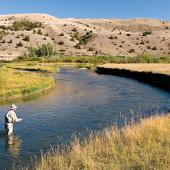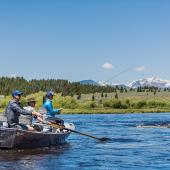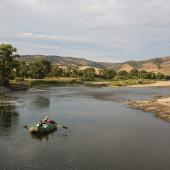Park Place
Fly fishing in the land of geysers.
Yellowstone Park lies at the center of some of the world’s best trout fishing. The variety of species, water types, and access is immense. To really do it justice, you’d need several 100-page books. The following survey of the Firehole, Yellowstone, and Lamar rivers is just a sampling of the unique waters and seasons of the Park.
Fishing season runs from the Saturday of Memorial Day weekend through October 31, though some waters open later. The native cutthroat, grayling, and mountain whitefish are catch-and-release everywhere, and all hooks must be barbless or de-barbed. There are special rules for particular areas within the Park, so be sure to know where you are and what rules are in play. An angler unfamiliar with the Park is well advised to seek out one of the many fly shops on the periphery for detailed advice.
Firehole River
When the Park season opens, most waters are either in full flood from the spring runoff or still frozen. Fortunately for the angler, the Firehole has been blessed by a relatively flat drainage which means that “high” water doesn’t necessarily mean muddy water, as it does elsewhere. Furthermore, the entire reach of the river from Madison Junction to Biscuit Basin is easily accessed from the road or via short, flat hikes. The Firehole, along with the Madison and lower part of the Gibbon River, is restricted to fly fishing.
Typically, the first week of the season yields classic nymph and wet-fly action, with patterns such as the bead-head prince nymph or various stoneflies in the lower canyon. As the water warms after the spring crest, hatches begin to appear. The lower canyon has a pocket hatch of salmonflies and other stones in early June. The flatter sections are graced with pale morning duns and several caddis species, giving the dry-fly angler about three weeks’ worth of opportunity.
By early July, the Firehole, which drains three large geyser basins, is too warm to fish. The river’s second season starts after the equinox as the cooler fall weather brings the water temperatures down. The fall hatches are mostly small mayflies, with baetis being the most common, as well as several caddis species. The fishing gets better as the weather deteriorates, right up until closing.
Lamar River
The Lamar drains a large segment of the Park and actually controls when the Yellowstone River will crest below their confluence. It also has a large amount of highly-erodible volcanic materials, so when the river is in flood it gets really muddy. Consequently, the fishing doesn’t start here until sometime in July. Fifteen miles of the river are easily accessible from the Northeast Entrance Road. A trail ascends the river above its confluence with Soda Butte Creek, giving access to another 20-plus miles of water.
Salmonflies and other stonefly hatches kickstart the season in the lower ten miles of the river, where the water is characterized by canyon and big-boulder pocket water. The Lamar Valley proper is the domain of the green-drake mayfly and terrestrials such as hoppers, ants, and beetles. High summer is the best season on the Lamar, as the fish get spookier and spookier into the fall until they are nearly impossible to find.
The fish are mostly cutthroat trout and average a fairly large size, spiced with pockets of rainbows and cutbow hybrids. Unfortunately, easy accessibility leads to crowding and the soils make the stream vulnerable to summer thunderstorms. Partly because of the overcrowding, the Lamar can also be quite temperamental, and the old adage comes to mind: “When she was good she was very, very good; but when she was bad she was horrid.”
Yellowstone River
The Yellowstone dominates the eastern and northern sections of the Park. It holds up well into the fall as the stoneflies are followed by caddis, terrestrials, and baetis. This also gives scope for nymph and streamer fishing through most of the season. Access is another issue. There are only a few spots where the roads approach the river near Gardiner and in the Tower Junction area. This makes the middle of the Black Canyon via the Blacktail Deer Creek Trail one of the prime spots to merge excellent-quality fish with a measure of solitude. The Yellowstone River Trail runs along the river near Tower Junction, as well as near Gardiner, making almost all of it accessible to those willing to put in the hike. Access to the Grand Canyon is more restricted. The Seven Mile Hole Trail provides the only access to the upper end of this reach, while the lower few miles can be accessed from Tower Falls and the Specimen Creek Trail.
Near Gardiner, the Yellowstone delivers native cutthroat and mountain whitefish along with rainbow, cutbow, brown trout, and even an occasional brookie. Knowles Falls, about eight miles above Gardiner, marks the upper limit of the browns and the whitefish, which peter out before you reach the Tower area. The likelihood of rainbow and cutbow also decreases quickly above the confluence with the Lamar, while the brookies are mostly confined to incidental occurrences near the mouths of creeks such as Blacktail, Deer, Elk, and Tower.
Richard Parks own Parks Fly Shop in Gardiner.












